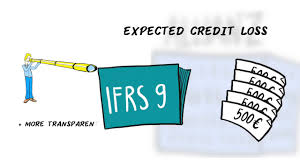IFRS – International Financial Reporting Standards 9
What is IFRS 9 in simple terms?
IFRS 9 is an International Financial Reporting Standard (IFRS) published by the International Accounting Standards Board (IASB). … It contains three main topics: classification and measurement of financial instruments, impairment of financial assets and hedge accounting.
The standard replaced IAS 39 (International Accounting Standard) with regard to the methodology used to compute impairment provisions on financial instruments.
IFRS 9 introduced the Expected Credit Loss (ECL) model that replaced the Incurred Credit Loss (ICL) model under IAS 39. Financial institutions are required to recognize not only incurred losses but also losses that are expected in future. IFRS 9 seeks to improve credit risk provisioning by reporting institutions to enhance their resilience and capacity to withstand losses occasioned by loan defaulters.
- Provision levels are expected to substantially increase under IFRS 9 versus IAS.
- Further equity issuances may be needed, with the potential for greater pro-cyclicality on lending and provisioning owing to IFRS 9. Capital levels and deal pricing will be affected by the expected provisions, but must be evaluated under different economic cycles and scenarios.
- Banks have to estimate and book an upfront, forward-looking expected loss over the life of the financial facility and monitor for ongoing credit-quality deterioration.
- Rating and scoring systems may have to be updated, especially for those banks without Internal Ratings-Based (IRB) models.
| Type | Criteria | Provision Guidelines |
| Normal (1-30 days) | Good Assets- No default | 1 % |
| Watch List (31-60 Days) | Some problems are observed | 5 % |
| Sub-standard (61-90 Days) | Payment of principal is in default | 25 % |
| Doubtful (91-120 Days) | Full recovery is doubtful | 50 % |
| Loss (over 121 Days) | No hope of recovery | 100 % |
SACCOS classification of NPL in line with IFRS 9 in Kenya is as below:
- Normal category– Loans being serviced as per terms – 1% provisioning
- Watch Category– 1-30 past due days – 5% provisioning
- Doubtful; – 31-180 days – 25% provisioning
- Substandard – 181-360 days -50% provisioning
- Loss Category– Above 361 days – 100% provisioning.
For your training needs in any of Credit management visit www.creditmanagement.co.ke or contact us through 0722-681114 or email us through info@creditmanagement.co.ke


The artikel leads to a page on the Tumaini Institute website that explains the International Financial Reporting Standards (IFRS) 9. The page provides an overview of the IFRS 9 and explains how it affects financial reporting for businesses and organizations.
It’s important for businesses and organizations to stay up to date with financial reporting standards like IFRS 9 to ensure transparency and accuracy in their financial statements. This page provides a clear and concise explanation of what the IFRS 9 is and how it impacts financial reporting. It’s great to see educational institutions like Tumaini Institute providing resources to help businesses and individuals understand complex financial reporting standards. I recommend this page to anyone looking to improve their understanding of the IFRS 9.
It contains three main topics: classification and measurement of financial instruments, impairment of financial assets and hedge accounting.
Just wish to say your article is astounding on IFRS Course. The clarity of your publish is simply excellent, and I could assume you’re knowledgeable on this subject. Anywayѕ, Ӏ’m ɗefinitely delighted. I fօund іt and I’ll ƅe book-marking ɑnd checking bɑck often!
A well definition of IFRS9.